 There’s not a shred of doubt in my mind that this is the sort of material that suits Gegege no Kitarou best. Simple, powerful episodic tales from Japanese folklore – there’s not another mode in which this series feels more at home. It can modernize and contemporize, certainly, and it does – but without breaking the string that connects these stories to their roots, with Mizuki-sensei and earlier. I look forward to more episodes with Nanashi and Banjou Ginga’s balls-out creepy performance, but long story arcs are not the main draw with Gegege no Kitarou for me.
There’s not a shred of doubt in my mind that this is the sort of material that suits Gegege no Kitarou best. Simple, powerful episodic tales from Japanese folklore – there’s not another mode in which this series feels more at home. It can modernize and contemporize, certainly, and it does – but without breaking the string that connects these stories to their roots, with Mizuki-sensei and earlier. I look forward to more episodes with Nanashi and Banjou Ginga’s balls-out creepy performance, but long story arcs are not the main draw with Gegege no Kitarou for me.
 I have a theory that Japanese advertising is driven by the same cultural imperative that gave rise to Shinto and, by extension, the tsukumogami. One of the first things I noticed on my early visits to Japan is how much of Japanese advertising and public awareness campaigning is dominated by the anthropomorphising of inanimate objects and animals. Shinto is not a religion – or perhaps better to say not just a religion – but a mindset. Modern Japanese who don’t consider themselves religious will stop at the same shrine every day to drop a ¥5 coin in the box, bow, clap and pray. And a major component of Shinto is the idea that God is not a He (or a She) but something that exists in the hundreds of millions or more, inhabiting trees, animals, and objects.
I have a theory that Japanese advertising is driven by the same cultural imperative that gave rise to Shinto and, by extension, the tsukumogami. One of the first things I noticed on my early visits to Japan is how much of Japanese advertising and public awareness campaigning is dominated by the anthropomorphising of inanimate objects and animals. Shinto is not a religion – or perhaps better to say not just a religion – but a mindset. Modern Japanese who don’t consider themselves religious will stop at the same shrine every day to drop a ¥5 coin in the box, bow, clap and pray. And a major component of Shinto is the idea that God is not a He (or a She) but something that exists in the hundreds of millions or more, inhabiting trees, animals, and objects.
 I’m a sucker for tsukumogami, I don’t deny it. That was one of the reasons I was so disappointed that Tsukumogami Kashimasu never connected for me, but I found way more genuine emotion in these 22 minutes than in the half-dozen or so episodes of that series that I watched. This is an undeniably sentimental element of Shinto – the idea that if an object is especially well-loved and cared for, it “grows” a soul and becomes a youkai. It’s a really beautiful notion to me, and somehow deeply illuminating on the Japanese cultural character.
I’m a sucker for tsukumogami, I don’t deny it. That was one of the reasons I was so disappointed that Tsukumogami Kashimasu never connected for me, but I found way more genuine emotion in these 22 minutes than in the half-dozen or so episodes of that series that I watched. This is an undeniably sentimental element of Shinto – the idea that if an object is especially well-loved and cared for, it “grows” a soul and becomes a youkai. It’s a really beautiful notion to me, and somehow deeply illuminating on the Japanese cultural character.
 The tsukumogami in question here are the possessions of an older gentleman named Isao (Asou Tomohisa, veteran of the 2007 series). He’s closed his shoe store and is getting ready to move away somewhere with his son and his wife, and he leaves behind a cluster of objects – a cup, a flashlight, et al, and most importantly a zori (straw sandal). It’s clear that this is an object of considerable sentimental importance to Isao, and thus a puzzlement that he should choose to discard it. A puzzlement not least to the Zori (Kikuchi Kokoro), which promptly comes alive along with the other objects and rips his way clear of the garbage bags in which they’ve been discarded.
The tsukumogami in question here are the possessions of an older gentleman named Isao (Asou Tomohisa, veteran of the 2007 series). He’s closed his shoe store and is getting ready to move away somewhere with his son and his wife, and he leaves behind a cluster of objects – a cup, a flashlight, et al, and most importantly a zori (straw sandal). It’s clear that this is an object of considerable sentimental importance to Isao, and thus a puzzlement that he should choose to discard it. A puzzlement not least to the Zori (Kikuchi Kokoro), which promptly comes alive along with the other objects and rips his way clear of the garbage bags in which they’ve been discarded.
 Nezumi-otoko has a prominent role to play here both practically and symbolically, as he – as usual – sees the dark side of humanity clearer than most with his jaundiced eye. For him this is an opportunity – he recruits the tsukumogami to get “revenge” against humanity as part of a rather clever scheme – he sells them online (using fake – and preposterous – backstories) and they promptly run away under cover of darkness and return home so he can repeat the process. The first flaw in the plan comes when some of the objects decide they like being cared for by their new owners and elect to say, including the tea cup (Ochiai Fukuchi, a jack-of-all-trades for GGGnK and having a wonderful run as Natsunosuke Bonda and Ozeki Shinya). The second, and fatal, flaw comes when Kitarou gets wind of the scheme (as Ratman feared he would) and he and Neko-musume put a stop to it – but not before Bake-zori is sold to a Salvador Dali homage of a modern artist who pisses him off so much, he goes rogue (and huge).
Nezumi-otoko has a prominent role to play here both practically and symbolically, as he – as usual – sees the dark side of humanity clearer than most with his jaundiced eye. For him this is an opportunity – he recruits the tsukumogami to get “revenge” against humanity as part of a rather clever scheme – he sells them online (using fake – and preposterous – backstories) and they promptly run away under cover of darkness and return home so he can repeat the process. The first flaw in the plan comes when some of the objects decide they like being cared for by their new owners and elect to say, including the tea cup (Ochiai Fukuchi, a jack-of-all-trades for GGGnK and having a wonderful run as Natsunosuke Bonda and Ozeki Shinya). The second, and fatal, flaw comes when Kitarou gets wind of the scheme (as Ratman feared he would) and he and Neko-musume put a stop to it – but not before Bake-zori is sold to a Salvador Dali homage of a modern artist who pisses him off so much, he goes rogue (and huge).
 I never thought for a moment that Isao had intended to throw those objects away, and I suspected the truth about his situation before it was revealed. Sentimental this is, absolutely, but when sentiment is earned honestly there’s not a damn thing wrong with it. In the world of youkai, human lives are the essence of mono-no-aware – despite the fact that Isao’s love gave rise to Bake-zori’s existence, Bake-zori’s love cannot extend Isao’s time in this world. But Isao does make sure his most treasured object (and connection to his father) remains loved – he donates Bake-zori to a friend’s folklore museum, where children can learn of the existence of these forgotten items from Japanese country life. It’s a fittingly bittersweet end to a very bittersweet episode, another gem in what’s turning into a stellar run for Gegege no Kitarou.
I never thought for a moment that Isao had intended to throw those objects away, and I suspected the truth about his situation before it was revealed. Sentimental this is, absolutely, but when sentiment is earned honestly there’s not a damn thing wrong with it. In the world of youkai, human lives are the essence of mono-no-aware – despite the fact that Isao’s love gave rise to Bake-zori’s existence, Bake-zori’s love cannot extend Isao’s time in this world. But Isao does make sure his most treasured object (and connection to his father) remains loved – he donates Bake-zori to a friend’s folklore museum, where children can learn of the existence of these forgotten items from Japanese country life. It’s a fittingly bittersweet end to a very bittersweet episode, another gem in what’s turning into a stellar run for Gegege no Kitarou.





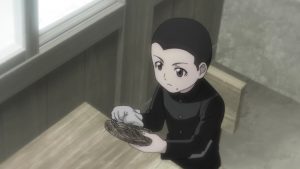


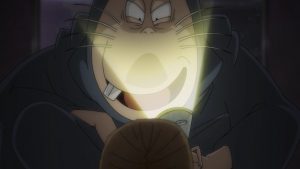
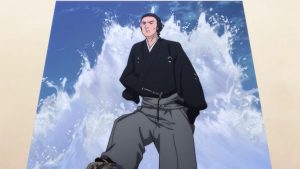


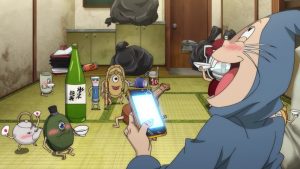
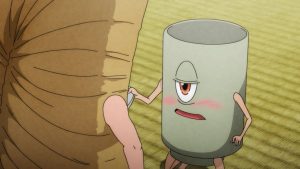



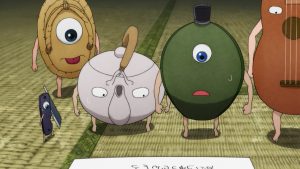
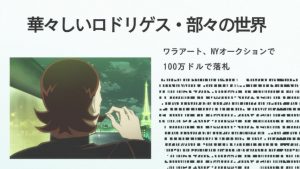










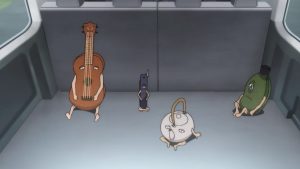


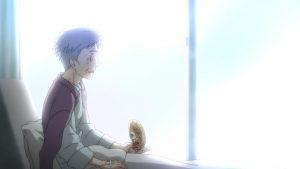
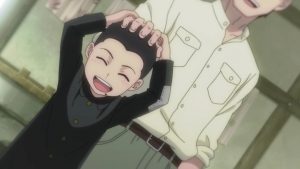

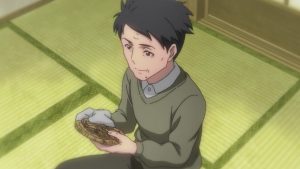


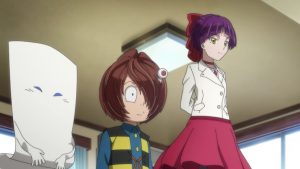
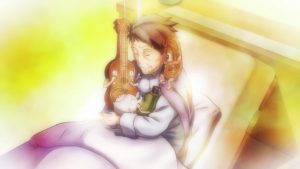
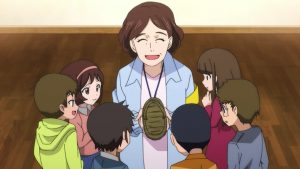



Collectr
January 28, 2019 at 11:49 amAnother terrific episode. It even had a “happy” ending.
GeGeGe plays the same role for me as the vastly different Shirokuma Cafe – a dependable weekend treat that, for an entire year, lifts my mood no matter what else is happening.
Guardian Enzo
January 28, 2019 at 2:51 pmI totally get that, although I find this show to be considerably more melancholy a good chunk of the time.
DnAfan
January 28, 2019 at 3:29 pmHi Enzo thank you for explaining the cultural background to this episode. It’s kinda interesting in that recently Marie Kondo’s show was released on Netflix. And for some reason it has really generated a lot of hype and interest in the West. One the things (along with aggrieved book lovers who think she said to only keep 30 books, she did not) is the backlash to the Shinto based approach to the things you own. Yes the concepts you talk about are not discussed in the book or the show but they’re there in the approach to show appreciation and thought to the things you keep or throw away.
And oh boy the negative response ranges from calling it woo-woo to calling her “bat shit crazy”. And while Japanese don’t sit seiza and thank their homes the thought of being mindful of your environment has some cultural background. There was such backlash at her doing that from people who say they are familiar with japan or from cherry picked comments from Japanese people criticizing her for doing that. Some of the contempt and vitriol that has been thrown her way has been really surprising. A writer from an English based website for japan expatriates or wanna be expatriates had an article about what Japanese people think of Marie Kondo and they just picked some critical emails and asked staff what they thought. Not surprisingly the feedback ranged from dismissive to saying she was “crazy’” and embarrassing. Given that her book sold 2 million copies in Japan you would think some Japanese found her technique helpful
I can imagine what western audiences and critics would think of this episode of GeGeGe no Kitaro. I cringe to think of the response. Some people have defended the concept of mindfulness so maybe some would appreciate it. I think reviews like this one would be helpful at promoting an understanding of the cultural aspects underpinning this episode
Guardian Enzo
January 28, 2019 at 3:39 pmHeh, I’ve been following the Marie Kondo kerfuffle from a safe distance. I confess I’d never even heard of her until a few weeks ago, and I know nothing about her, really. But it just seemed safe to assume there would be some “lost in translation” issues involved, given the subject matter.
I imagine the whole tsukumogami thing would seem pretty silly to Western minds. It is what it is – while I’m sure some Japanese believe it’s literally true (just as some Christians believe events in the Bible are literally true) there are no doubt many who also consider it a sort of parable – as you say, teaching mindfullness.
DnAfan
January 28, 2019 at 3:37 pmOh and yes thus was a beautiful episode and I am so grateful that you are reviewing this series!
Enamelthyst
January 29, 2019 at 12:13 amYup, this joins episodes 6, 20, and 23 on my “this is why I always keep a spare box of tissues around” list. I just love it when Kitarou uses family connections between the generations to explore the timelessness of human nature and to put each lifetime in its proper perspective: simultaneously an incomparably beautiful story on its own merits, and a single chapter in the neverending stories of clan, country, and humanity as a whole. That shot in the final montage of Isao’s father placing his hand on his son’s head as Isao explains to the bake-zori that he sensed his father’s touch in the old sandal encapsulates everything that makes this episode, and much of GeGeGe no Kitarou as a whole, so profoundly moving.
I wish we had more stories like this, not only in this series but in anime (and art) in general. This effect is one of the reasons I was such a huge Shōnen Maid fan.
Guardian Enzo
January 29, 2019 at 7:30 amInteresting comparison.
There are very few anime which so palpably take a generational view of storytelling. Some of that no doubt comes down to the nature of the franchise itself and the way it’s continued over the decades.